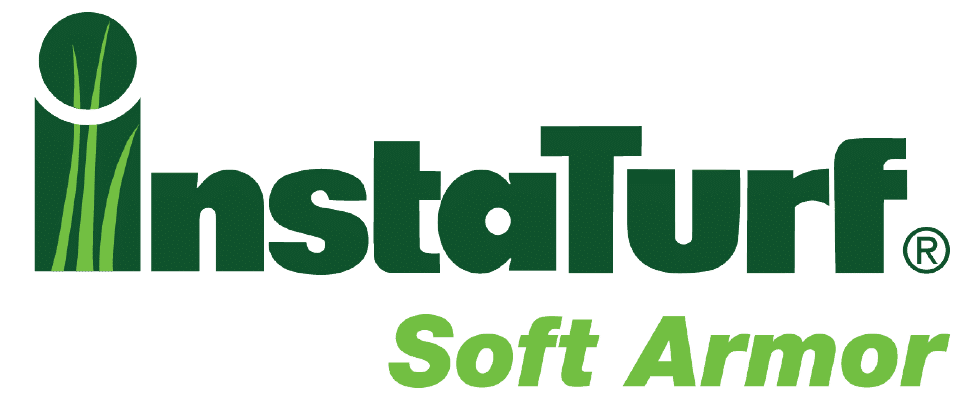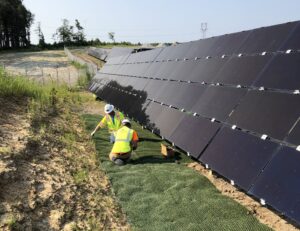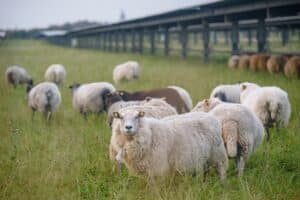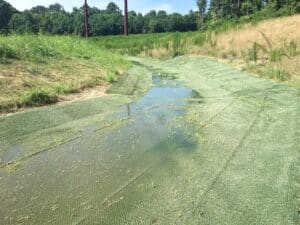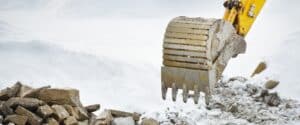Rolled erosion control products (RECPs) have been on the market in various forms since as early as the 1950s. They were first introduced as simple jute mats imported from Asia and erosion control blankets made in the U.S. from wood excelsior fibers and nettings. Since that time, there have been numerous innovations and improvements in product technology, making RECPs one of the fastest-growing segments in the erosion control industry.
Today, there are several types of rolled erosion control products, each with its own specific uses, design considerations, and limitations. Deciding which one will provide sufficient erosion control and be better for the task at hand should be influenced by these factors. There are two major classes of RECPs to choose from: temporary RECPs and permanent RECPs. Temporary rolled erosion control products are typically biodegradable, photo-degradable or a combination of both. These products, as the name implies, help control soil erosion for a relatively short period of time while establishing vegetation. Open weave textiles (OWTs), mulch control nets (MCNs), and erosion control blankets (ECBs) fall within this category.
Permanent rolled erosion control products are manufactured primarily with non-degradable, weather-resistant materials. Turf reinforcement mats (TRMs) comprise this category of RECPs. TRMs are composed of synthetic materials such as filaments, fibers, mesh, and nets, manufactured into a three-dimensional matrix. Some TRMs also contain organic fibers, meant to help establish vegetation faster. But in doing so, these products sacrifice some of their long-term reinforcement and erosion control properties. As with temporary erosion control products, TRMs provide some level of short-term protection and enhancement of vegetation establishment.
However, TRMs further offer long-term protection and structural reinforcement for the vegetation once established. In doing so, TRMs actually increase the erosion resistance of vegetation and enable its use in place of hard armor materials such as rock riprap, for protecting high flow channels, shorelines, riverbanks, and outfalls. Below, we look at some of the design considerations and limitations of TRM-reinforced vegetation when using these materials for permanently armoring such areas.
Turf Reinforcement Mat Applications
TRMs function as a permanent reinforcing system enabling vegetation to grow in areas subjected to high erosive forces that would exceed the limits of natural, unreinforced vegetation. Traditionally, hard armor materials such as concrete or rock riprap were used in these areas due to their increased erosion resistance. Yet, these hard armor materials are usually costlier than TRMs and do not provide the same environmental benefits as “soft armor” vegetative systems. TRMs now make it possible to use vegetation in severe applications once reserved for hard armor materials, such as:
- Steep gradient and/or long slopes
- High-flow drainage channels
- Water diversions
- River, canal, and streambanks
- Outfalls and down chutes
- Pond and lake dams, spillways and shorelines
Design Considerations of TRM-Reinforced Vegetation
Vegetation Selection
When striving to use vegetative systems for armoring a high flow area, one must first assess if the area will sustain long-term growth of the desired vegetation type. Areas with extremely shady conditions, poor soils, droughty soils, wet soils, or submergence for extended periods, may not be conducive to growing the desired vegetation or may necessitate the use of other species adapted to grow in such conditions. Nevertheless, if the high flow area at hand will not support long-term growth of the planned-upon vegetation, a non-vegetative hard armor solution may be the only option for effective permanent protection.
After confirming the suitability of the vegetation for a specific site, the next step is to determine whether or not a permanent RECP is necessary for long-term reinforcement. For areas where shear stresses generated by flows from the design storm event will not exceed the permissible shear stress of the desired permanent stand of vegetation, then a temporary RECP may be used to simply hold soil and seed in place until vegetation establishment.
According to the USDA’s National Engineering Handbook (Aug, 2007), permissible shear stress limits of different types of vegetation with various stand characteristics typically range from 2 lbs/sf up to 7.5 lbs/sf (see Table 1. below). The permissible shear stress of any given type of vegetation is based on its stand height, density, growth habit (clump or sod-forming), and erodibility of the soil on which it grows. Short, sparse stands of bunch-type grasses growing on highly erodible soils will register on the low-end of the permissible shear spectrum, while tall, dense stands of sod-forming grasses established on less erodible soils will have higher shear stress limits. One may consult the USDA Handbook mentioned above for design procedures and calculations to analyze the desired vegetation type/s on the project at hand. Manning’s roughness coefficients for various vegetative stands are also published in this document to enable estimation of maximum flow depth and calculation of Maximum Shear Stress, based on the design discharge (cf/s) in the high flow area.
Table 1. Permissible Shear Stress Ratings for Channel Lining Materials (various sources)
- Natural (Unreinforced) Vegetation – 2 lbs/sf – 7.5 lbs/sf (USDA NEH, 2007)
- Conventional TRMs, Unvegetated – 2.5 lbs/sf – 3.2 lbs/sf (AASHTO NTPEP ASTM D6460)
- Simulated Turf High Flow Erosion Control Mat, Unvegetated – 10 lbs/sf – 12 lbs/sf (ASTM D6460)
- Conventional TRM-Reinforced Vegetation – 12 lbs/sf – 16 lbs/sf (ASTM D6460)
- Simulated Turf High Flow Erosion Control Mat, Vegetated – 14 lbs/sf – 16 lbs/sf (ASTM D6460)
- 24-inch Rock Riprap – 9.6 lbs/sf (FHWA HEC#15, 2005)
- 30-inch Rock Riprap – 12 lbs/sf (FHWA HEC#15, 2005)
- 36-inch Rock Riprap – 14.4 lbs/sf (FHWA HEC#15, 2005)
On the other hand, if the design flow conditions exceed the permissible shear stress of the desired stand of vegetation, then a TRM should be considered for reinforcing and increasing the vegetation’s erosion resistance.
There are numerous types of TRMs on the market, each with their own configurations and limitations. When choosing one, the designer should consider both hydraulic and non-hydraulic stresses the TRM is expected to be subjected to in the given application.
Hydraulic Stresses
The primary function of TRMs immediately after installation is to prevent soil and seed migration or loss during storm flows in order for the vegetation to take hold and mature. This period of time, when the TRM must provide stand-alone protection with little or no vegetation, is often considered the most crucial phase in the long-term success of the TRM-reinforced vegetative system.
As it can often take 6 -12 months for vegetation to establish and develop a mature root system, this crucial phase must not be ignored, especially since most “conventional” TRMs provide somewhat limited erosion protection on their own. That said, there are new turf reinforcement mats available, known as InstaTurf ShearForce simulated turf high flow erosion control products, which offer reinforced-turf-like performance from day one of installation to better prevent erosion during this crucial period and ensure the development of a permanently reinforced vegetative stand. (see Table 1.)
Type of vegetation, location of the project, soil fertility, climatic conditions, and when the project is seeded, can all influence the length of time it takes for maturation.
As such, selecting an appropriate TRM for any given application should entail calculating maximum shear stresses from discharges expected on the TRM before and after vegetation establishment. The following equation may be used to calculate maximum shear stress on a pre-vegetated and vegetated TRM under channelized uniform flow conditions:
T= YxDxS
Where,
T – Maximum shear stress (lbs/sf)
Y – Unit weight of water (62.4 lbs/cf)
D – Maximum flow depth (ft)
S – Energy gradient or channel bed slope (ft/ft)
According to ASTM D6460 large-scale channel liner testing on TRMs conducted by AASHTO’s National Transportation Product Evaluation Program (NTPEP), conventional TRMs typically have unvegetated permissible shear stress ratings of around 3 lbs/sf. Meaning, concentrated water flows generating shear stresses of 3 pounds per square foot or more will cause significant erosion of the underlying soil, seed loss, and subsequent failure of the TRM to develop future vegetation. On the other hand, as tested with 12 months of vegetation growth, the permissible shear stress ratings of these products increase up to and beyond 12 lbs/sf.
This discrepancy between the unvegetated and fully vegetated performance ratings must be considered during the design process. Historically, channel lining design guidance published by the Federal Highway Administration (FHWA) in the Hydraulic Engineering Circular #15 (1988 and 2005) suggested using the projected flow discharge from a 2-year storm event to calculate shear stress for comparison to a TRM’s unvegetated permissible shear stress rating, and subsequent determination of its short-term effectiveness.
To determine the TRM’s suitability for long-term channel protection, the flow discharge from a 10-year (or greater) design storm event should then be used to calculate expected shear stress for comparison to the TRM’s fully vegetated permissible shear stress rating. While this “two-phase” channel lining design approach may have been sufficiently conservative in the less severe climatic conditions of the late 1900’s and early 2000’s, one may argue that the more frequent, higher intensity storm events we face today warrant a more conservative design approach, particularly in avoiding failures of TRMs before vegetation establishment.
One such approach would be to simply use the flow discharge from the project’s design storm event (commonly 10, 25, 50 or 100-year) to calculate expected shear stress on the TRM without any vegetation, for comparison to the TRM’s unvegetated permissible shear stress rating. This “worst-case” analysis would generate the most conservative results with lowest level of risk for the designer. Good news is, the new InstaTurf ShearForce high flow erosion control products, with unvegetated permissible shear stress ratings exceeding that of 24-inch rock riprap, allow engineers to confidently utilize more vegetation in their designs, even when using this more conservative design approach.
Non-Hydraulic Stresses
In addition to flow-induced shear stresses, designers should also take into consideration any non-hydraulic stresses that the TRM will likely encounter. While modern TRMs are designed to withstand the rigors of installation and occasional mowing once vegetated, they will not support extremely heavy loads or frequent vehicular traffic, especially during wet soil conditions. Furthermore, large debris and ice flows in waterways can damage TRMs, especially before vegetation establishment.
So caution should be used when considering TRMs for installation shortly before periods when debris or ice flows are common. For steep slope applications, TRMs can provide effective surficial erosion protection on gradients up to and exceeding 1:1 (H:V), but they will not prevent slope slumping or sloughing due to internal stability issues. Note that some High-Performance TRMs (HPTRMs), with tensile strengths exceeding 3,000 lbs/ft and deeply secured with earth anchors, may prevent shallow “veneer” failures on slope faces. But beware that such HPTRMs do not necessarily have better pre-vegetated and/or vegetated erosion resistance than conventional TRMs with less tensile strength.
In summary, properly designed TRM-reinforced vegetation can provide highly cost-effective, environmentally friendly armoring for many high flow applications. Designing with TRMs that deliver maximum pre-vegetated erosion protection as well as long-term vegetation reinforcement, such as the new InstaTurf Shearforce turf reinforcement mats, will further ensure the long-term success of your reinforced vegetative systems.
